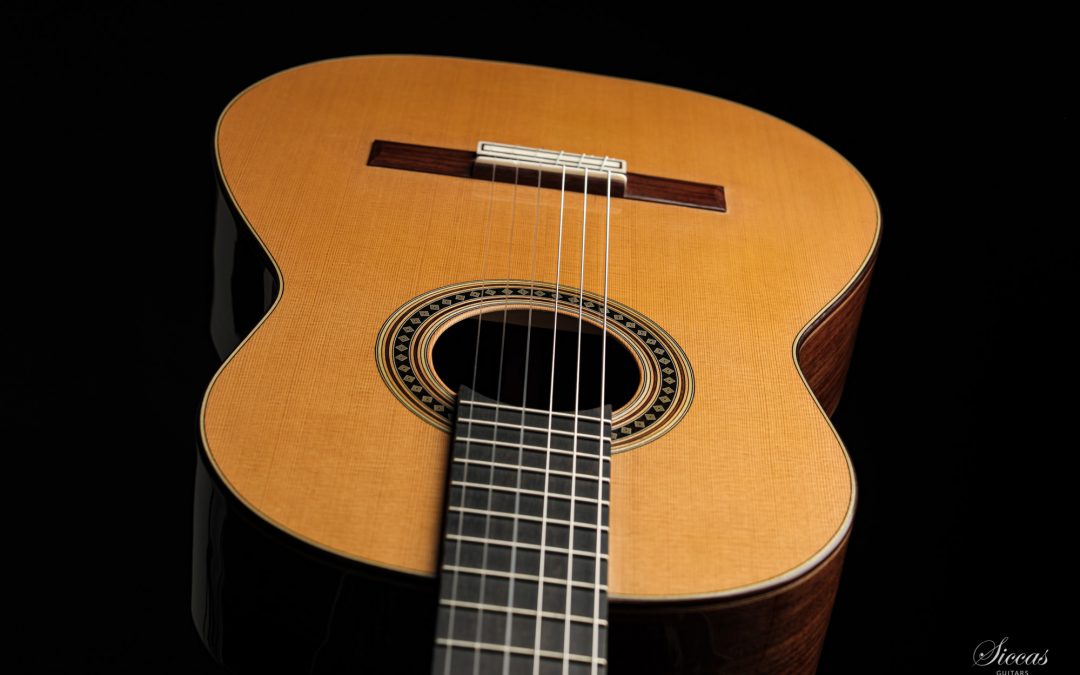
Classical Guitars
The Classical Guitar
The classical guitar has existed for many years and is older than the modern acoustic guitar. The main distinguishing feature that sets it apart from other guitars is the use of nylon strings. This gives the classical guitar an instantly recognizable sound and produces a tone like no other stringed instrument.
These traditional guitars are available in a wide variety of woods and are suitable for players of all styles. They can be an extremely affordable choice for beginners, and the softer nylon strings are a gentler alternative to steel-string acoustics. Premium-level models can be found for professional players and those who enjoy instruments with special visual features. Classical guitars, suitable for both fingerpickers and strummers, have already been used on countless records, ranging from country ballads to pop hits.
At Siccas Guitars, we carry one of the largest selections of classical guitars in Europe. Whether you are looking for a first guitar for a young beginner or the exceptional instrument of your dreams, we can help you find your dream guitar.
What is the difference between an acoustic and a classical guitar?
The main difference is the use of nylon strings instead of steel strings. This changes the sound and feel. It also means that classical guitars do not need a truss rod inside the neck. Classical guitars usually have flatter fingerboards and may have slightly thicker necks.
Can you play a classical guitar like an acoustic guitar?
There is certainly no rule that says you cannot! Since both have 6 strings and traditionally the same standard tuning, you can play acoustic songs on a classical guitar. It will sound slightly different due to the nylon strings, but some may actually prefer this sound.
Can you use steel strings on a classical guitar?
No, we strongly advise against using steel strings on a classical guitar. Since classical guitars do not have a truss rod inside the neck like steel-string guitars, steel strings are not suitable. The additional tension could easily cause permanent and irreparable damage to the guitar’s neck.
Are all nylon-string guitars classical guitars?
The use of nylon strings is a defining feature of the classical guitar. These strings give it a distinctive sound and feel that set it apart from the modern acoustic guitar. There are nylon-string guitars with electric features, but these are generally still regarded as a form of the classical guitar.
How does a classical guitar differ from an acoustic guitar?
Classical guitars differ from standard steel-string acoustic guitars in several ways, not least by the wider neck – up to 2″ – to accommodate more complex fingerings.
You will also find differences in construction, body shape, and weight distribution. The bracing is usually lighter and arranged to enhance the guitar’s resonance, while classical and flamenco guitars also tend to have a shallower body depth compared to, for example, a dreadnought acoustic guitar.
Within classical guitars, you will also find differences between flamenco and traditional nylon-string classical guitars, with flamenco guitars often featuring a golpeador to protect the soundboard during percussive techniques. The neck of a flamenco guitar also tends to be flatter, allowing for a lower action and deeper playability.
In addition to classical and flamenco nylon-string guitars, there are also hybrids that borrow some features and aesthetics from “regular” guitars – such as narrower necks – providing a good middle ground for those who want the warm, soft sound of nylon but do not want to completely change their playing technique.

















